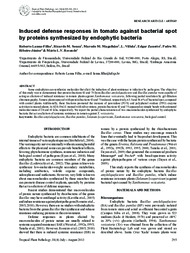Induced defense responses in tomato against bacterial spot by proteins synthesized by endophytic bacteria.
Induced defense responses in tomato against bacterial spot by proteins synthesized by endophytic bacteria.
Author(s): LANA-FILHO, R.; SOUZA, R. M.; MAGALHÃES, M. M.; VILLELA, L.; ZANOTTO, E.; RIBEIRO-JÚNIOR, P. M.; RESENDE, M. L. V.
Summary: Some endophytes can synthesize molecules that elicit the induction of plant resistance to infection by pathogens. The objective of this study was to demonstrate that protein fractions 42 and 75 from Bacillus amyloliquefaciens and Bacillus pumilus were capable of acting as elicitors of induced resistance in tomato plants against Xanthomonas vesicatoria, following partial resolution by gel-filtration chromatography. Tomato plants sprayed with protein fractions 42 and 75 reduced, respectively, 63.5 and 56.6% of bacterial spot, compared with control plants. Additionally, these fractions promoted the increase of peroxidase (POX) and polyphenol oxidase (PPO) enzyme activities in treated plants. In SDS-PAGE stained with silver nitrate, protein fractions 42 and 75 appeared as simple bands with estimated molecular mass of 28 and 43 kDa, respectively. We report the partial characterization of two macromolecules synthesized by endophytic bacteria that act as elicitors of systemic resistance in tomato against X. vesicatoria.
Publication year: 2013
Types of publication: Journal article
Unit: Embrapa Eastern Amazon
Keywords: Bacillus amyloliquefaciens, Bactéria, Controle Biológico
Observation
Some of Embrapa's publications are published as ePub files. To read them, use or download one of the following free software options to your computer or mobile device. Android: Google Play Books; IOS: iBooks; Windows and Linux: Calibre.
Access other publications
Access the Agricultural Research Database (BDPA) to consult Embrapa's full library collection and records.
Visit Embrapa Bookstore to purchase books and other publications sold by Embrapa.

